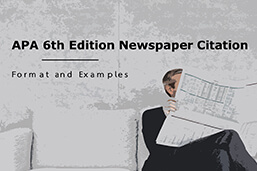
The APA style manual is the go-to guide to creating professional, consistent, and easy-to-read references in psychology, sociology, and the social sciences. The 6th edition provides a standardized method for newspaper citation in terms of crediting the sources. This citation style helps to maintain academic integrity as well as avoid plagiarism by ensuring the author is credited appropriately. This article outlines the format and style of APA 6th edition newspaper citation.
Definition: APA 6th edition newspaper citation
APA 6th edition newspaper citation covers all forms of public “print” media (e.g., magazines, broadsheets, tabloids, websites). Referencing ephemera lets researchers establish context, examine public debate, and analyse broader discussion. Every (correct) APA 6th edition newspaper citation includes the article’s name, publication, date (including the day), and the named author. However, the end section varies depending on the media format referenced.
in Your Thesis
APA 6th edition newspaper citation: Online editions
Online edition formatting covers any publication with both an online and traditional print presence (e.g., The Times, The Guardian, New Scientist). It’s also practical for referencing easily retrievable digitized archive articles. A URL (i.e., web address) replaces the usual page numbers. Using the top-level URL for the publication’s website avoids future “dead” links.
| APA Format: | Author(s) Surname(s), First Initial(s) [X.]. (Year, Month and Day of First Publication). Article Title [or Headline]. Publication [in itallics]. Retrieved from Publication URL [Top] |
| APA Reference (List): | Example, A.N. (2009, June 30). New APA Edition Simplifies Referencing. Grammar Daily. Retrieved from https://GDO.URL |
| In-Text Citation: | In an article about APA 6th edition newspaper citation (Example, A.N., 2009)... |
APA 6th edition newspaper citation: Articles in print
The formatting for print edition article references in the 6th edition APA is very similar to online citations. However, you’ll need to state the exact page number(s) (or sections) instead of citing a top-level URL. Start with “p.” for single sheets, and use “pp.” for a citation across two or more pages. If unconventional section markers appear (e.g., Letter-Number “A1” formatting), those should always supersede and replace standard numbering.
| APA Format: | Author(s) Surname(s), First Initial(s) [X.]. (Year, Month and Day of First Publication). Article Title [or Headline]. Publication [in itallics]. Page Number(s) [p. or pp. Start Page XX, End Page YY.] |
| APA Reference (List): | Example, A.N. (2009, June 30). New APA Edition Simplifies Referencing. Grammar Daily. pp. 3,13. |
| In-Text Citation: | In an article about APA 6th edition newspaper citation (Example, A.N., 2009)... |
APA 6th edition newspaper citation: Only online news sites
Some news organizations (e.g., Reuters, BBC News, Associated Press) publish exclusively online. With online-only sources, the URL needs to be more precise. Include the link whole. Don’t cite the website name again. State the original release date for the article – not the date you first viewed it. Don’t use italics.
| APA Format: | Author(s) Surname(s), First Initial(s) [X.]. (Year, Month and Day of First Publication). Article Title [or Headline]. Retrieved from Publication URL [In Full] |
| APA Reference (List): | Other, A.N. (2009, August 1). New Grammar Guide Rocks Internet. Retrieved from https://AwesomeAPA.URL/articles/ABC321 |
| In-Text Citation: | As Awesome APA once wrote on their website (Other, A.N., 2009)... |
FAQs
State a top-level or sub-level URL at the end of your reference instead of page numbers.
Yes – if you cite a fixed URL link. It may be better to reference a reliable repeat of the post in question.
Cite the online version (if possible). Historic print media is harder to access and misses later additions or clarifications.
